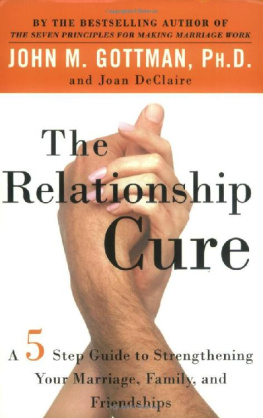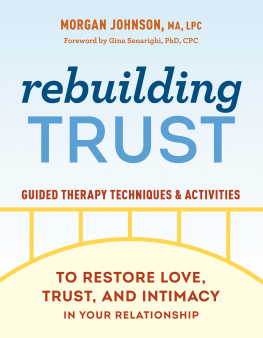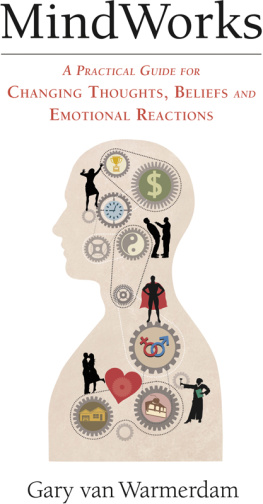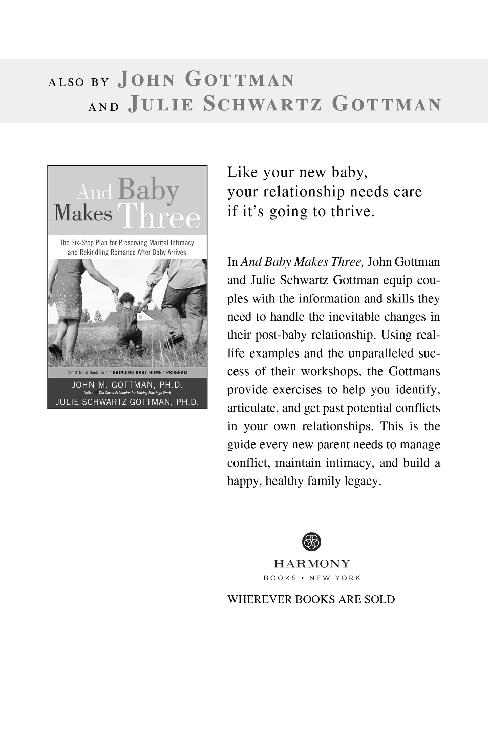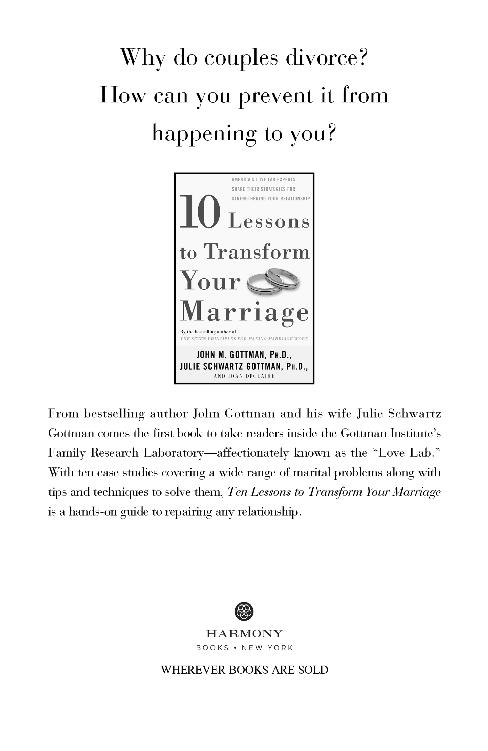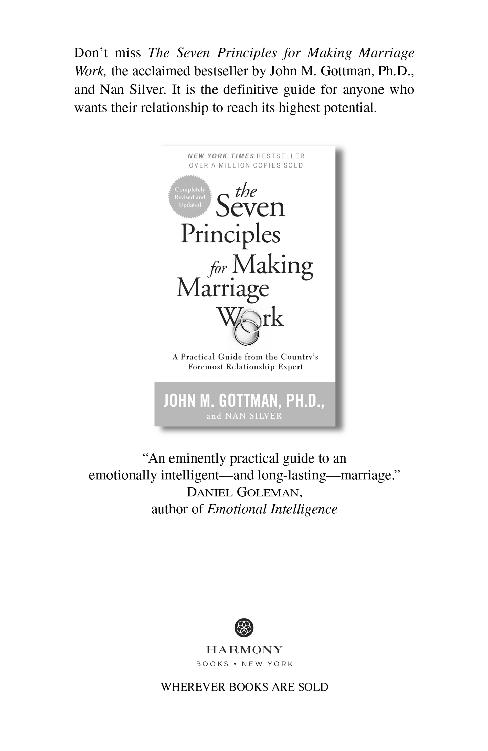

This book has emerged primarily from three wonderful collaborations. The first is with my coauthor, Joan DeClaire, who has put a great deal of herself into this book and put up with many frustrations as we puzzled through the ideas in this work. It has been a huge creative effort, the scope of which we didnt understand when we began. Second is the collaboration I have had with my very dedicated and very talented student Jani Driver. She did the hard work of building the bids and turning system from our apartment-lab data. It has been great fun working with her and seeing her talents develop. An amazing scholar and an intuitive observer, she has the potential to become a fine scientist and clinician. The third is the collaboration with my wife, Dr. Julie Schwartz Gottman, who put aside all her many obligations to do the powerful drawings for this book. I greatly appreciate all of her energy and talent in completing these drawings. She also brings to my work a great intuition and sensitivity for people, and every year I keep being more amazed at her depth of understanding and compassion. Without Julies vision, hope, optimism, and encouragement, my laboratory and my work would not be thriving today.
The research that has resulted in this book was made possible by the continuous support I have received from my core laboratory staff, Dr. Sybil Carrere, Catherine Swanson, and Sharon Fentiman. We have been together and friends for more than a decade, and somehow it all works smoothly and keeps getting better all the time. Whether we are doing a television show or running a major study, we continue to be a great team. I also need to thank Virginia Rutter, whose energy, creativity, and imagination have been great at helping me bring this work to the publics attention.
I want to thank the staff of the Gottman Institute, particularly Etana Dykan, Peter Langsam, Kelly Scandone, Shai Steinberg, and Linda Wright, for all their support in planning and running workshops.
Thanks also to the many students and staff who have taught me so much about relationships, particularly Julian Cook, Joann Wu Shortt, Angie Mittman, Jim Coan, Melissa Hawkins, Carole Hooven, Vanessa Kahen Johnson, Lynn Katz, Regina Rushe, Kimberly Ryan, Kristin Swanson, Amber Tabares, Rebecca Tyson, Beverly Wilson, and Dan Yoshimoto.
I would like to acknowledge the amazingly insightful integrative work of Jaak Panksepp, whose great vision about affective neuroscience formed the basis for our work on the emotional command systems. Ive read Jaaks book three times and still have not tapped its great potential.
The National Institute of Mental Health, particularly Drs. Molly Oliveri and Carolyn Morff, have generously supported my work on relationships. Recently, Ron Rabin, executive director of the Kirlin Foundation, and Craig Stewart, executive director of the Apex Foundation, have provided enormous support and encouragement of my work. They have emerged from the darkness and shown me the light ahead.
And thanks to Mark Malone for his help with the manuscript.
J.G.
Also by John Gottman
Meta-Emotion:
How Families Communicate Emotionally with Lynn Katz and Carole Hooven
The Heart of Parenting:
How to Raise an Emotionally Intelligent Child with Joan DeClaire
The Analysis of Change
Why Marriages Succeed or Fail with Nan Silver
What Predicts Divorce?
The Seven Principles for Making Marriage Work with Nan Silver
A work team at one of Seattles floundering Internet companies has a problem thats common in many workplaces: They cant communicate with their boss. If you catch a few team members at a local tavern after hours, youre likely to hear an exchange something like this:
Joseph is the coldest fish Ive ever worked for.
I know what you mean. The other day I saw this picture of a little boy on his bulletin board and I said, Cute kid. Is that your son? And he goes, No.
And that was it?
Yeah. So Im standing there wondering, Well, who is it then? Your nephew? Your stepson? Your love child?
Hes just so out of it. And to think we were so jazzed when we heard he was going to head the team, with that vaunted success record of his.
Hes smart, all right. But what good has it done us? We still havent launched the site.
Thats because he has zero people skills. Have you noticed how all the other managers try to avoid him?
Yeah, thats whats screwing us up. We have no real standing in the company. I was hoping he could take our ideas up the ladder and wed finally get the resources we need. But he never asks for our input. He never even asks if youve had a nice weekend.
Remember when we moved to the new building and he decided to do away with private offices? He said wed have an open floor plan to enhance communication. What a crock!
Stop it, you guys. I feel sorry for him.
Sorry for him? Why? Hes the one with all the stock options!
Well, I think he wants to be a better bosshe just doesnt know how.
Oh yeah? How can you tell?
I dont know. Its just a guess. Maybe he knows how disappointed we all feel in him. And that makes it even harder for him. I cant read his mind, but I bet thats whats going on.
Next meet Kristine, age fifty-four, an advertising executive whose mother was recently diagnosed with Alzheimers disease. Kristine would like to help with her mothers care, but Mom lives several states away, near Kristines sister, Alice. Heres a typical phone call between the sisters:
Hows Mom? Kristine asks tentatively.
Shell be better once the insurance pays her hospital bill, Alice responds. Thats all she talks about.
But that was last December. The insurance still hasnt paid?
No, not

